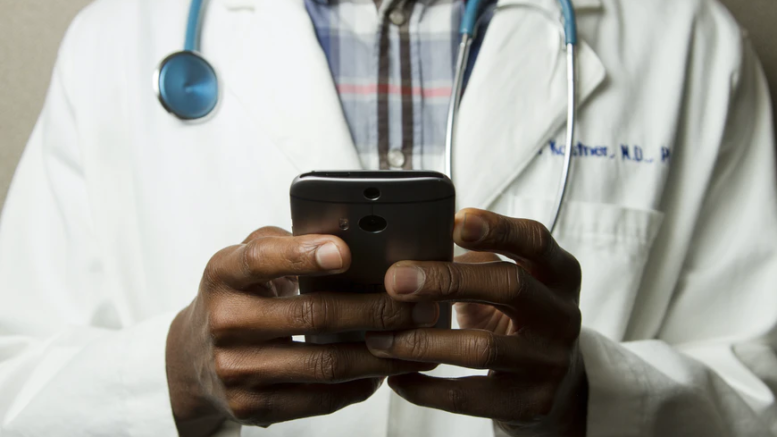Can you imagine going anywhere these days without seeing people glued to their cell phones or tablets? Social media is the new virtual way of life for modern human beings. It’s shaped not only the ways that we interact with one another, but it’s also transforming the way we seek information and entertainment. It’s infiltrating the workplace as well as the home.
But what about the doctor’s office? The hospital? The clinic? Does social media, in other words, have any place in modern healthcare? The answer, now more than ever, is a resounding yes.
In this new, technology-driven information age, social media promises to be a powerful tool in optimizing healthcare not only on a local or national scale but on a global one as well. With social media and healthcare app development, providers and health educators have the power to extend care to nearly every corner of the world. We’ll show you how.

The Rise of Telemedicine
When it comes to the digitization of healthcare, the benefits of telemedicine have increased. In fact, because it is increasing access to care for many patients, it’s starting to look a bit more like the one-on-one doctor/patient clinical encounter we’re accustomed to. The difference is that evaluations are conducted remotely, usually through a PC webcam or a smartphone video-sharing app, or a wearable device.
That means that patients who traditionally may not have had access to reliable, ongoing care, such as those who live in rural areas or who are elderly or disabled, can now connect with their healthcare team whenever and wherever they need to.
This not only ensures that patients have access to the essential treatments they need, from medications to mental health counseling, but it also helps to promote preventative care. Physicians, counselors, nurses, and health educators can use telemedicine, including remote patient monitoring systems, to identify patient risk factors and provide essential education in nutrition, fitness, and other early intervention strategies to ensure that a potential problem does not mushroom into a full-blown health crisis.
The Turn Toward Social Media
Telemedicine and mHealth are trailblazing an essential new path in the provision of healthcare access to previously disenfranchised patient populations, even as they promote the continuity and quality of patient care for all patients, regardless of access download gdiplus.dll. However, these technologies are only the tip of the iceberg when it comes to patient outreach.
Social media is proving to be an incredible resource for healthcare providers and institutions to access patients who need them most. Social media advertising shows a lot of benefits in connecting patients worldwide with the organizations and resources they may need.

Raising Awareness
In addition to using social media to build an institutional brand and link patients with the experts best able to serve them, these platforms are also turning out to be a particularly effective forum for raising public awareness on important physical, mental, and emotional health issues. Social media, for example, is becoming crucial to health communicators in answering patient questions, disseminating the latest health information, and even helping to quell rumors and misinformation. And if the recent outbreak of the novel coronavirus teaches us anything, it’s that misleading and sometimes dangerous health rumors can spread like wildfire on the internet.
Through social media, patients and families can access not only healthcare providers and organizations but also support networks and community forums. There, patients and families can ask questions and solicit emotional support both from medical practitioners as well as from those who have actually lived with the illness or injury of concern.
For patients who may be confronted with the diagnosis of a rare disease, social media may provide the only opportunity to connect on a regular basis with fellow survivors and their caregivers. And when you are fighting for life and health–or when you’re trying to support a loved one through their own battle–that compassion and understanding can give you just the motivation you need to fight on to another day!
Looking Beyond Facebook
If you’re a healthcare provider looking to harness the power of social media in your own practice, it’s time to think outside the box—or the “ ‘Book.” Facebook, that is. Studies show that, as a marketing tool, Facebook is well past its prime.
Today, social media users are increasingly looking to video content for the information they seek. They’re also turning now more than ever to voice-assisted searches, driven principally by the growing popularity of Alexa, Google Home, and the grandmothers of them all, Siri and Cortana.
So if you want your practice to take the pride of place when it comes to telehealth and health education, then traditional text-based social media won’t cut it. Your patients will expect multimedia interactivity, from video and voice to chatbots and other forms of health AI.
The Takeaway
Social media isn’t just for work and play anymore. Today, the immense power and scope of social media are being exploited to provide access to high-quality healthcare and health education to patients worldwide. Through pioneering achievements in telemedicine, mHealth, and social media marketing and communications, patients and healthcare providers are coming together to raise health awareness and promote continuity and quality of care on a global scale. The result, it is to be hoped, is a more just, equitable, and accessible global healthcare system—and a happier and healthier patient population the world over.
Author’s Bio
Aston is a content writer and application developer. She does research and discussion on tech-related topics. She enjoys sharing her experiences with a like-minded audience and writes about software development, digital marketing, business, career, and more.
